Cheonan Corvette: a story without a final conclusion
The death of the South Korean corvette "Cheonan" was so difficult history, in which truth, half-truth, fiction, falsehood and concealment of facts, which even now, ten years later, is not easy to understand, are intricately intertwined. Due to some political events, it acquired in some places anecdotal character. I do not see tragedies in the death of sailors - it was their duty and oath, especially since the corvette was very close to the hostile waters.
Corvette with combat experience
Corvette "Cheonan" (English name ROKS Cheonan, tactical number - PCC-772), class "Pohang". Displacement 1200 tons, length 88 meters. The maximum stroke is 32 knots. It was an anti-submarine corvette. Onboard there are 6 torpedo tubes (Mark 46 torpedoes), 12 bombers (Mark 9 depth charges), as well as two 76-mm guns, two 40-mm guns and four launchers of the Garpun anti-ship missile system.
The ship was launched in 1989, the fourteenth ship in the series, and in the same year was commissioned fleet. On June 15, 1999, the corvette took part in the first battle near Yonphendo Island (east of the Pennёndo Island, near which the corvette later died, on the same Northern demarcation line). North Korean torpedo boats, patrol ship and patrol boats exchanged fire with South Korean corvettes and patrol boats. The Cheonan fired from its 76 mm and 40 mm cannons, so the southerners won. They managed to sink the North Korean torpedo boat, seriously damage the patrol ship and get into patrol boats. The Cheonan sustained light feed damage.
So the ship was with history and participation in a real battle. Which makes the whole story of his death even stranger. Nevertheless, the crew, and especially the officers, some of whom could serve on the ship from the moment of the battle, knew very well that they were in the waters, where there could be all sorts of surprises from sworn compatriots, and there was some chance of being attacked.
Some solid facts
Strange things do not end there, but only envelop the story of the corvette's death even more densely. In fact, in the whole heap of statements, reports, and various information leaked to the press, there are very few facts that would be established quite firmly.
Known date, time and place. March 26, 2010 at 21.33 local time, when the corvette was located about a mile west of the island of Pannyondo, a strong explosion occurred. Five minutes later, the corvette broke into two parts. The stern sank near the site of the explosion at a depth of 130 meters, and the bow carried to the southern part of the island 3,5 miles from the site of the explosion, and it sank at a depth of 20 meters so that a small part of the hull protruded from the water. Of the 104 crew members, 46 were killed; Interestingly, all the officers survived.
Both parts of the corvette were then raised, examined and then placed in the naval memorial. The destruction was more than impressive and showed that the corvette was destroyed by a powerful underwater explosion.
Reliable facts include the study of an underwater explosion seismogram made in 2014 by a group of researchers (So Gu Kim - Korean Seismological Institute, Efim Gitterman - Geophysical Institute, Israel, Orlando Rodriguez - University of the Algarve, Portugal), which determined that the explosion power was 136 kg of TNT, the explosion occurred at a depth of 8 meters with a sea depth of 44 meters. This conclusion, by the way, refutes the opinion that the corvette ran into an old bottom mine, which was placed in this area in the 1970s. Bottom mines are equipped with a much larger explosive charge, up to a ton or more, and the calculated explosion power more closely matches the charge of a torpedo.
Also, employees of the University of Virginia (USA) and the University of Manitoba (Canada), Son Hong Lee and Pansok Yang, carried out spectroscopic and X-ray diffraction studies of samples of the substance taken from the tail of the torpedo (presumably North Korean), from the corvette body and the control sample obtained from the test explosion. South Korean experts believed that the substance is an aluminum oxide formed during the explosion. However, X-ray diffraction analysis showed that it was not aluminum oxide, in addition, the data for the three samples did not match and the third sample did not match the first two. Comparison with control samples showed that the samples taken from the torpedo and the corvette body correspond to aluminum hydroxide, a substance that does not form during the explosion, but which forms during corrosion of aluminum in sea water, and it is continuous. Researchers concluded that the South Korean report bears signs of falsification and therefore is invalid.
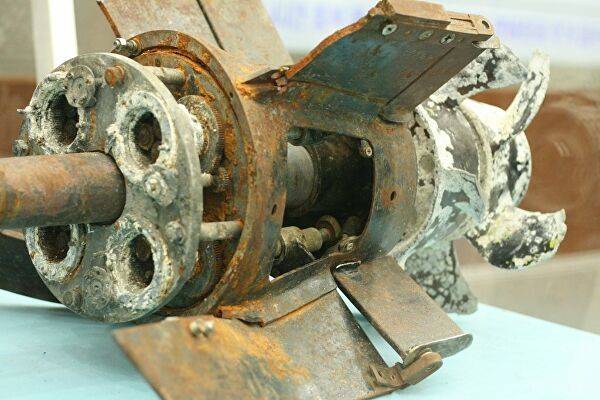
There was some controversy, in my opinion, to no avail: the parties remained unconvinced. It is understandable, because it was proved that the torpedo fragment presented by the South Koreans was not related to the explosion under the corvette.
A paradoxical situation. It is known for sure that the corvette was blown up and sank, but how and on what - it remained unclear.
Versions, Versions ...
You need to start with firmly established facts, so that later you do not become a slave to one of the versions, which, subject to objections, has been expressed a lot. The version makes up for the absence of firmly proven facts by various assumptions, building the picture to some integrity. But with regard to the death of Cheonan, there were so few hard facts that in versions the assumptions and assumptions replaced the facts.
There are three major versions.
First: a North Korean submarine sank a corvette with its torpedo. The version in South Korea is official, and was even used at the UN to demand the imposition of sanctions on the DPRK.
Second: the corvette ran into an old bottom mine that exploded. This version was voiced at the beginning of the epic by the Ministry of Defense of South Korea.
Third: "friendly fire", that is, the corvette was sunk by a torpedo fired from an American submarine. This version is most detailed by Japanese researcher Tanaka Sakai.
Of these, you can take the first two versions.
The North Korean version is not very suitable for purely technical reasons. The torpedoes used in the DPRK CHT-02D will not undermine the corvette as it did. This type of torpedo comes (directly or with Chinese mediation) from the Soviet SAET-50 torpedo, which, in turn, comes from the German TV Zaunkönig torpedo, from which they took the homing acoustic system. It follows that, firstly, the North Korean submarine needed to go 600-800 meters to the corvette so that the homing system confidently took the target. Secondly, the system induces a torpedo to the noise of the propellers, and it explodes under the stern, in the region of the propeller-steering group.
It is worth adding here that there is information that is not generally disproved, that along with the Cheonan there was a Sokcho corvette of the same type - ROKS Sokcho (PCC-778), and it even fired at some target (this is the Ministry of Defense of the Republic of Kazakhstan already refuted), and that the corvette or corvettes constantly used active sonar. So the northerners would not be able to approach the distance of a confident shot, especially to two corvettes at once, without being detected. Shooting from afar - wasting a torpedo. In addition, the corvette was blown up in the engine room area, and its screws and rudders are intact (the screws are slightly bent, but the cause of the damage is unclear; possibly, they bent when lifting). That is, it was not a North Korean torpedo and not a North Korean attack.
The version about the bottom mine has already been largely refuted by indicating the depths. Bottom mines can be set to a depth of 40-50 meters, and in this area there were very large-scale underwater minefields in the 1970s (Tanaka mentions the setting of 136 bottom mines). However, over time, the batteries are discharged and the mine comes into an unfit state. The mine delivered at that time certainly couldn’t undermine anything in 2010, because it lay in the water for more than 30 years. Undermining a ship on an old and already incapable of exploding bottom mine is possible only when the ship is bulked onto it, which can only be in shallow water. Analysis of the seismogram of the explosion showed that under the keel of the Cheonan there were 44 meters, that is, this is not his case.
The version about the bottom mine was born in the Ministry of Defense of the Republic of Kazakhstan in the very first hours after reports that the nose of the corvette was found in shallow water near the island of Pannyondo, and in conditions of acute lack of information and the need to give at least some explanation of what happened, the version of the bottom mine this is the first thing that comes to mind.
Now only the version about the American torpedo remains. Despite the fact that it looks very conspiratorial, and Tanaka Sakai’s presentation is also unreliable, because it involves the death of an American submarine, which is easily refuted by comparison with the list of dead boats. It is impossible to hide the loss of a combat unit and the death of a crew.
Technically, I think, “friendly fire” is possible, since it better matches the picture of a ship blasting. The torpedo Mark 48 has an active sonar guidance system, as well as, according to some information, a device for responding to the ship’s magnetic and electromagnetic field. With such equipment, the torpedo really aims at the midship of the ship and explodes under the keel where the ship’s magnetic and electromagnetic field is the strongest, that is, in the engine room area, where the most massive steel parts are, where the generator is located.
Therefore, I believe that the version with "friendly fire" looks the most likely and it explains why this whole international scandal with the DPRK accusations flared up. He had to cover up some unsightly sides of what had happened.
What could be?
I will draw up my version of events based on the American, but with amendments. It, like any version, provides for some logical reconstruction of the events that we know are extremely incomplete and inaccurate. In the case of the Cheonan corvette, only a tiny fraction of the really useful information reached the public, despite all the hype and multilateral expert commissions.
In fact, my version boils down to the fact that on the evening of March 26, 2010, two South Korean corvettes and an American submarine met west of Pennondo Island. Why they ended up in this area is unknown; this could be part of the Key Resolve / Foal Eagle exercises that took place at that time (according to the Ministry of Defense of the Republic of Kazakhstan, the stage of the exercises with the development of anti-submarine missions took place elsewhere, 75 miles from the island; the ministry stated that Cheonan did not participate in the exercises ), but could be a separate operation, possibly related to reconnaissance missions, in order to feel the northerners. In general, they met, they did not recognize each other, it is not known why. It can be assumed that the southerners discovered the periscope of the boat, decided that it was a North Korean boat and fired at it. It is possible that Sokcho opened fire; it remains unclear whether he shot before the explosion or after. Apparently, they also intended to succumb to depth charges. The American boat also did not recognize the allied corvettes and, having come under fire, considered them hostile ships, responding to the shelling by a torpedo. Shot and hit. Then the boat went to the island, about three miles from the site of the explosion and, perhaps, was there for some time. In any case, Tanaka Sakai writes with references to South Korean sources about the discovery of a third underwater object, except for the sunken stern and bow of the corvette. Soon this object disappeared somewhere. If the boat still got damaged, then moving away to the island and patting up is a perfectly reasonable decision for submariners. When the situation cleared up and a rescue operation began, the boat went to base.
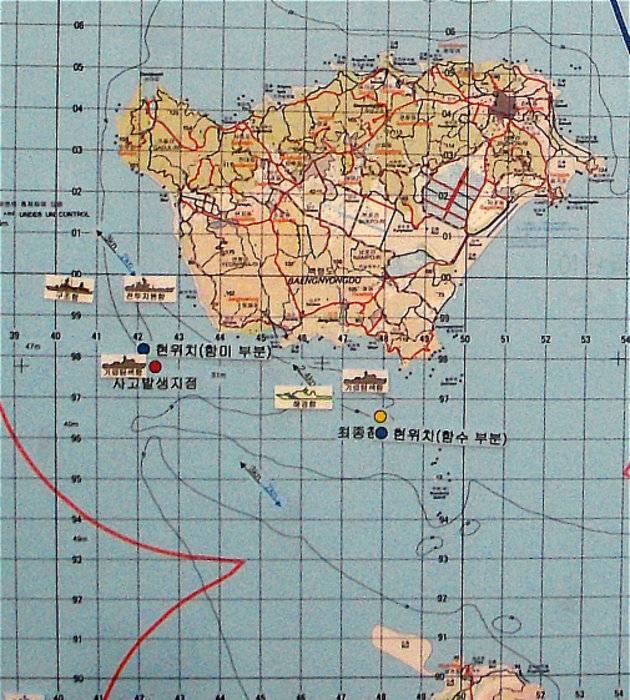
In principle, this happens. Moreover, according to some information leaked to the South Korean press, the command was not so good. For example, the head of the Joint Chiefs of Staff of South Korea, General Lee Sang-yi, was drunk that evening, so much so that he could not come to the command center, and then tried to hide it. The incident cost him the post, he resigned in June 2010. Well, if the head of the headquarters committee during the large-scale (largest) military exercises so lays behind his uniform collar, then what is it to be surprised that the allied ships at night in the sea, near enemy waters, started firing at each other?
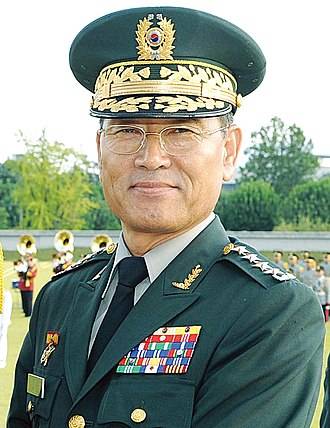
All the hysteria surrounding the death of Cheonan had a powerful political, primarily domestic political motive: in this way different parties and factions in the South Korean establishment solved their tasks. They were not at all embarrassed by the fact that they actually attributed a brilliant victory to the North Korean submarine fleet: the boat approached the anti-submarine corvettes unnoticed, threw a torpedo into one of them, and left without being discovered. Upper class! The memorial in which the Cheonan was installed after the rise turned out to be, in fact, a memorial in honor of North Korean submariners, where excursions were taken at the state expense, they told and showed how the northerners of the South Korean fleet beat as they want.
Watching the tantrum in South Korea, I asked myself only one question: if the war, then the northerners will drown the southerners in a bucket? So it turns out, or what?
So the official version (as if a North Korean submarine was sunk by a corvette) needs to be considered precisely from a political point of view, since it is technically untenable and has caused numerous objections even in South Korea itself, up to the point that skeptics were threatened with a repressive national security law.
There are many gaps and missing details in this story. And I can express my confidence that we will learn about this exactly only after decades, when archives will be available and some meticulous historian will get to them.
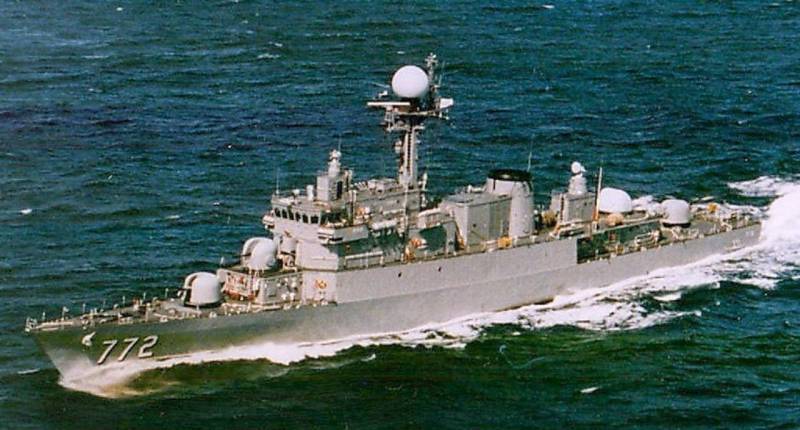
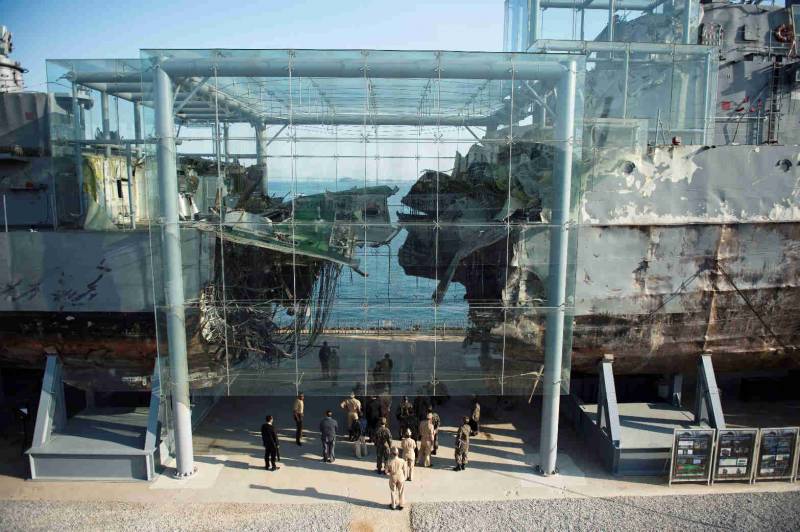
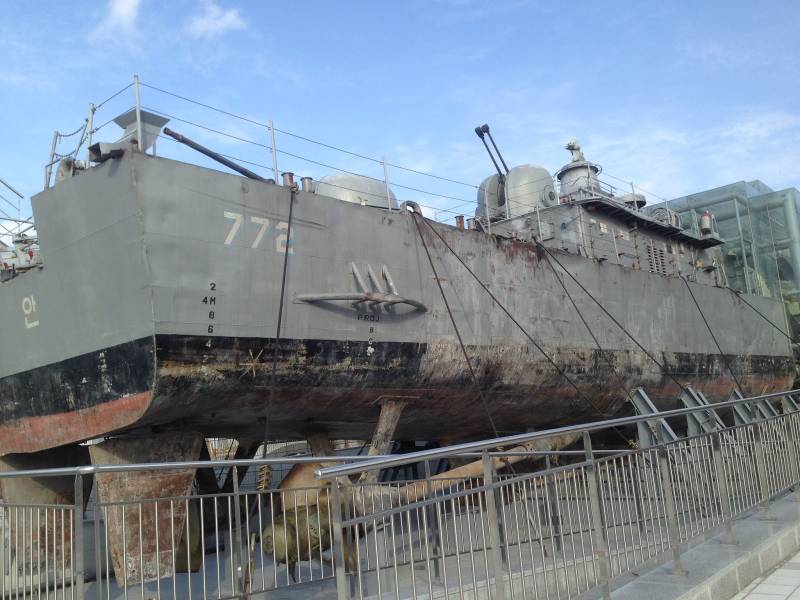
Information